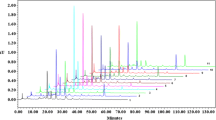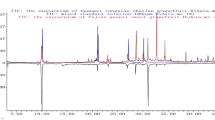Abstract
Fuzzy chromatography mass spectrometric (FCMS) fingerprinting methods in combination with principal component analysis (PCA) and soft independent modeling by class analogy (SIMCA) were developed for phenolic profiling and differentiation of American cranberry cultivars. Two FCMS fingerprinting methods, ion mobility fuzzy chromatography mass spectrometric (imFCMS) and conventional FCMS, are compared in the study. PCA and SIMCA successfully differentiated the cultivars with both methods. The six cultivars used formed three distinct groups in the PCA score plots, and each group contained one wild selection cultivar and its genetically related hybrid(s). Compared with FCMS fingerprinting, imFCMS fingerprinting provided better intra-cultivar sample clustering and inter-cultivar sample separation in PCA and superior sample classification sensitivity in SIMCA. Ultra-performance liquid chromatography–high-resolution mass spectrometry (UPLC–HRMS) analysis was conducted on selected samples to profile the phenolic difference between the cultivars. Compound identification using UPLC–HRMS revealed that flavonoid compounds, including flavonol glycosides, proanthocyanidins and anthocyanins, are major components that contribute to the phenolic profile variation among cultivars.







Similar content being viewed by others
References
Pappas E, Schaich KM. Phytochemicals of cranberries and cranberry products: characterization, potential health effects, and processing stability. Crit Rev Food Sci Nutr. 2009;49:741–81.
Zuo Y, Wang C, Zhan J. Separation, characterization, and quantitation of benzoic and phenolic antioxidants in American cranberry fruit by GC-MS. J Agric Food Chem. 2002;50:3789–94.
Borowska EJ, Mazur B, Kopciuch RG, Buszewski B. Polyphenol, anthocyanin and resveratrol mass fractions and antioxidant properties of cranberry cultivars. Food Technol Biotechnol. 2009;47:56–61.
Vvedenskaya IO, Vorsa N. Flavonoid composition over fruit development and maturation in American cranberry, Vaccinium macrocarpon Ait. Plant Sci. 2004;167:1043–54.
Krueger CG, Reed JD, Feliciano RP, Howell AB. Quantifying and characterizing proanthocyanidins in cranberries in relation to urinary tract health. Anal Bioanal Chem. 2013;405:4385–95.
Denis M-C, Desjardins Y, Furtos A, et al. Prevention of oxidative stress, inflammation and mitochondrial dysfunction in the intestine by different cranberry phenolic fractions. Clin Sci. 2015;128:197–212.
Howell AB, Reed JD, Krueger CG, Winterbottom R, Cunningham DG, Leahy M. A-type cranberry proanthocyanidins and uropathogenic bacterial anti-adhesion activity. Phytochemistry. 2005;66:2281–91.
Neto CC. Cranberry and its phytochemicals: a review of in vitro anticancer studies. J Nutr. 2007;137:186S–93S.
Reed J. Cranberry flavonoids, atherosclerosis and cardiovascular health. Crit Rev Food Sci Nutr. 2002;42:301–16.
Raman S, Hodes D. Cultural issues in child maltreatment. J Paediatr Child Health. 2012;3:30–7.
Vorsa N, Johnson-Cicalese J. American cranberry. Fruit breeding. Berlin: Springer; 2012. p. 191–223.
Wang Y, Johnson-Cicalese J, Singh AP, Vorsa N. Characterization and quantification of flavonoids and organic acids over fruit development in American cranberry (Vaccinium macrocarpon) cultivars using HPLC and APCI-MS/MS. Plant Sci. 2017;262:91–102.
Oszmiański J, Lachowicz S, Gorzelany J, Matłok N. The effect of different maturity stages on phytochemical composition and antioxidant capacity of cranberry cultivars. Eur Food Res Technol. 2018;244:705–19.
Chen P, Sun J, Ford P. Differentiation of the four major species of cinnamons (C. burmannii, C. verum, C. cassia, and C. loureiroi) using a flow injection mass spectrometric (FIMS) fingerprinting method. J Agric Food Chem. 2014;62:2516–21.
Chen P, Harnly JM, de Harrington PB. Flow injection mass spectroscopic fingerprinting and multivariate analysis for differentiation of three Panax species. J AOAC Int. 2011;94:90–9.
Gao B, Lu Y, Qin F, et al. Differentiating organic from conventional peppermints using chromatographic and flow injection mass spectrometric (FIMS) fingerprints. J Agric Food Chem. 2012;60:11987–94.
Lu Y, Gao B, Chen P, Charles D, Yu L. Characterisation of organic and conventional sweet basil leaves using chromatographic and flow-injection mass spectrometric (FIMS) fingerprints combined with principal component analysis. Food Chem. 2014;154:262–8.
Geng P, Zhang M, Harnly JM, Luthria DL, Chen P. Use of fuzzy chromatography mass spectrometric (FCMS) fingerprinting and chemometric analysis for differentiation of whole-grain and refined wheat (T. aestivum) flour. Anal Bioanal Chem. 2015;407:7875–88.
Geng P, Harnly JM, Chen P. Differentiation of bread made with whole grain and refined wheat (T. aestivum) flour using LC/MS-based chromatographic fingerprinting and chemometric approaches. J Food Compos Anal. 2016;47:92–100.
Mesleh MF, Hunter JM, Shvartsburg AA, Schatz GC, Jarrold MF. Structural information from ion mobility measurements: effects of the long-range potential. J Phys Chem. 1996;100:16082–6.
Glaskin RS, Khatri K, Wang Q, Zaia J, Costello CE. Construction of a database of collision cross section values for glycopeptides, glycans, and peptides determined by IM-MS. Anal Chem. 2017;89:4452–60.
Vvedenskaya IO, Rosen RT, Guido JE, Russell DJ, Mills KA, Vorsa N. Characterization of flavonols in cranberry (Vaccinium macrocarpon) powder. J Agric Food Chem. 2004;52:188–95.
Carpenter JL, Caruso FL, Tata A, Vorsa N, Neto CC. Variation in proanthocyanidin content and composition among commonly grown North American cranberry cultivars (Vaccinium macrocarpon). J Sci Food Agric. 2014;94:2738–45.
Brown PN, Shipley PR. Determination of anthocyanins in cranberry fruit and cranberry fruit products by high-performance liquid chromatography with ultraviolet detection: single-laboratory validation. J AOAC Int. 2011;94:459–66.
Lin LZ, Sun J, Chen P, Monagas MJ, Harnly JM. UHPLC-PDA-ESI/HRMSnprofiling method to identify and quantify oligomeric proanthocyanidins in plant products. J Agric Food Chem. 2014;62:9387–400.
Sun J, Chen P. A flow-injection mass spectrometry fingerprinting method for authentication and quality assessment of Scutellaria lateriflora-based dietary supplements. Anal Bioanal Chem. 2011;401:1581–8.
Hill HH, Bendiak B, Clowers B, Zhu M. Ion mobility-mass spectrometry analysis of isomeric carbohydrate precursor ions. Anal Bioanal Chem. 2009;394:1853–67.
Dwivedi P, Bendiak B, Clowers BH, Hill HH. Rapid resolution of carbohydrate isomers by electrospray ionization ambient pressure ion mobility spectrometry-time-of-flight mass spectrometry (ESI-APIMS-TOFMS). J Am Soc Mass Spectrom. 2007;18:1163–75.
Wu C, Siems WF, Klasmeier J, Hill HH. Separation of isomeric peptides using electrospray ionization/high-resolution ion mobility spectrometry. Anal Chem. 2000;72:391–5.
Acknowledgements
This study is supported by the Agricultural Research Service of the US Department of Agriculture and an Interagency Agreement with the Office of Dietary Supplements of the National Institute of Health. The authors are thankful to Professor Nicholi Vorsa at Rutgers University for providing cranberry samples.
Author information
Authors and Affiliations
Corresponding author
Electronic supplementary material
Below is the link to the electronic supplementary material.
About this article
Cite this article
Wang, Y., Chen, P. Comparison of Ion Mobility Fuzzy Chromatography Mass Spectrometric (imFCMS) Fingerprinting and FCMS Fingerprinting for Differentiation of American Cranberry Cultivars. J. Anal. Test. 2, 223–234 (2018). https://doi.org/10.1007/s41664-018-0059-3
Received:
Revised:
Accepted:
Published:
Issue Date:
DOI: https://doi.org/10.1007/s41664-018-0059-3




